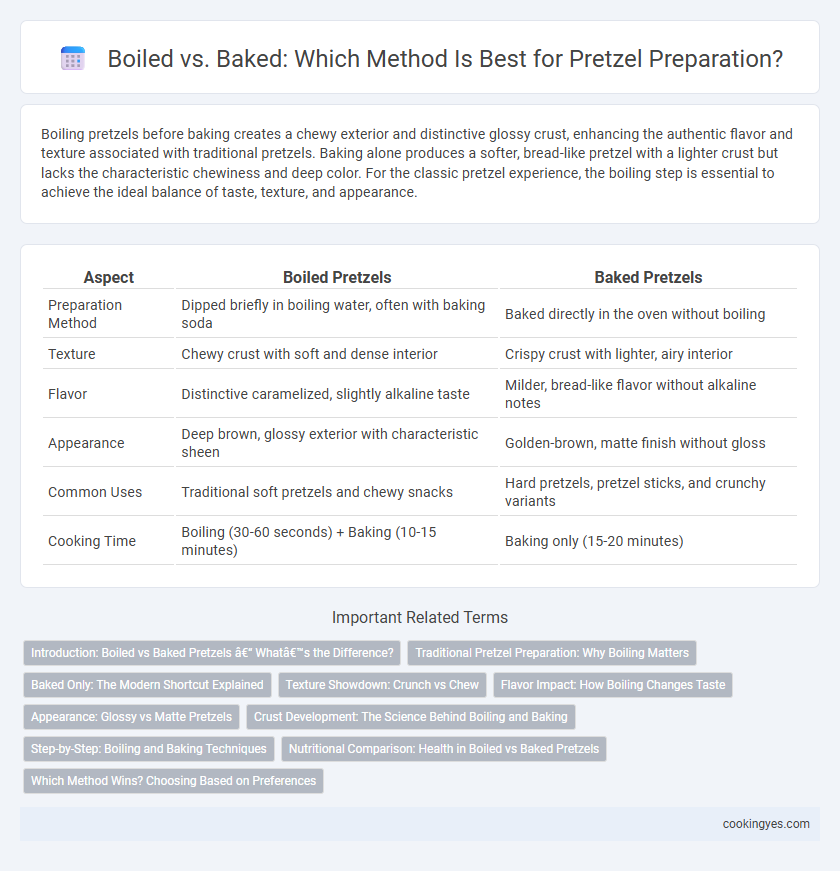Boiling pretzels before baking creates a chewy exterior and distinctive glossy crust, enhancing the authentic flavor and texture associated with traditional pretzels. Baking alone produces a softer, bread-like pretzel with a lighter crust but lacks the characteristic chewiness and deep color. For the classic pretzel experience, the boiling step is essential to achieve the ideal balance of taste, texture, and appearance.
Table of Comparison
| Aspect | Boiled Pretzels | Baked Pretzels |
|---|---|---|
| Preparation Method | Dipped briefly in boiling water, often with baking soda | Baked directly in the oven without boiling |
| Texture | Chewy crust with soft and dense interior | Crispy crust with lighter, airy interior |
| Flavor | Distinctive caramelized, slightly alkaline taste | Milder, bread-like flavor without alkaline notes |
| Appearance | Deep brown, glossy exterior with characteristic sheen | Golden-brown, matte finish without gloss |
| Common Uses | Traditional soft pretzels and chewy snacks | Hard pretzels, pretzel sticks, and crunchy variants |
| Cooking Time | Boiling (30-60 seconds) + Baking (10-15 minutes) | Baking only (15-20 minutes) |
Introduction: Boiled vs Baked Pretzels – What’s the Difference?
Boiled pretzels undergo a brief dip in alkaline water, creating a chewy crust with a deep brown color and unique flavor, while baked pretzels skip this step, resulting in a softer texture and lighter appearance. The alkaline boiling stage triggers the Maillard reaction, enhancing the pretzel's signature taste and glossy finish. Understanding these preparation differences is key to mastering authentic pretzel characteristics.
Traditional Pretzel Preparation: Why Boiling Matters
Boiling pretzels in a baking soda solution before baking creates the signature chewy crust and deep brown color by gelatinizing the dough's surface starches. This step enhances the traditional pretzel texture, distinguishing it from regular bread and allowing Maillard reactions to occur during baking, which develops the rich flavor. Skipping the boiling phase results in a softer, less flavorful pretzel lacking the characteristic crust and color.
Baked Only: The Modern Shortcut Explained
Baked pretzels offer a modern shortcut by skipping the traditional boiling step, relying on precise oven temperatures and dough formulation to achieve a golden-brown crust and soft interior. This method emphasizes convenience and consistency, ideal for commercial production and home baking without extended preparation. Adjusting hydration levels and baking times ensures texture and flavor closely match those of boiled pretzels while streamlining the process.
Texture Showdown: Crunch vs Chew
Boiling pretzels in a baking soda solution creates a unique outer crust with a golden-brown color and a distinct crunch that contrasts with the soft, chewy interior. Baking pretzels without boiling results in a uniformly tender texture but lacks the signature crispy bite that defines traditional pretzels. Texture enthusiasts often debate boiling as the key step to achieve the iconic combination of crunchy crust and chewy crumb in pretzel preparation.
Flavor Impact: How Boiling Changes Taste
Boiling pretzels in a baking soda solution creates a distinctive chewy texture while imparting a complex, slightly tangy flavor due to the Maillard reaction occurring during baking. This process enhances the pretzel's outer crust, resulting in a deep golden-brown color and a subtle hint of caramelization that cannot be achieved by baking alone. Without boiling, pretzels tend to have a softer crust and milder taste, lacking the signature savory and slightly alkaline flavor characteristic of traditional pretzels.
Appearance: Glossy vs Matte Pretzels
Boiling pretzels before baking produces a glossy, dark brown crust due to the Maillard reaction enhanced by the alkaline lye solution, creating a signature sheen and slightly chewy texture. In contrast, baked-only pretzels have a matte finish with a lighter color and a softer, bread-like exterior lacking the traditional glossiness. The boiling step is crucial for achieving the pretzel's characteristic appearance and distinct crust quality.
Crust Development: The Science Behind Boiling and Baking
Boiling pretzels in a baking soda solution creates a gelatinized starch layer on the surface, essential for achieving the characteristic chewy crust and deep brown color through the Maillard reaction during baking. The alkaline environment from boiling enhances crust browning and flavor development, while baking solely without boiling results in a softer, paler crust lacking signature texture. This combination of boiling and baking optimizes crust chemistry, producing the traditional pretzel's distinctive crispy exterior and chewy interior.
Step-by-Step: Boiling and Baking Techniques
Boiling pretzels in a baking soda solution creates a unique chewy texture and deep brown color by gelatinizing the dough's surface starches. Baking follows boiling, using high oven temperatures around 425degF (220degC) to develop a crisp, golden crust while preserving the soft interior. Precise timing, typically 30 seconds boiling and 12-15 minutes baking, is crucial to achieve authentic traditional pretzel quality.
Nutritional Comparison: Health in Boiled vs Baked Pretzels
Boiled pretzels typically have a lower glycemic index due to their denser crust formed during the boiling process, which slows carbohydrate absorption and helps maintain steady blood sugar levels. Baked pretzels may contain slightly more calories and fat if topped with oils or butters, while boiled pretzels often have fewer additives and less fat, making them a generally healthier option for weight management. Both types provide moderate amounts of protein and carbohydrates, but boiled pretzels offer better hydration and digestibility due to their unique preparation method.
Which Method Wins? Choosing Based on Preferences
Boiling pretzels before baking creates a chewy crust and glossy finish by gelatinizing the starches on the surface, while baking alone produces a softer, bread-like texture with less sheen. Preference for boiled pretzels often aligns with traditional German-style recipes, valued for their distinctive crust and flavor, whereas baked-only methods appeal to those seeking a lighter, less dense snack. Ultimately, the winning method depends on whether crispiness and authentic texture or softness and ease are prioritized in pretzel preparation.
Boiled vs Baked for Pretzel preparation Infographic

 cookingyes.com
cookingyes.com